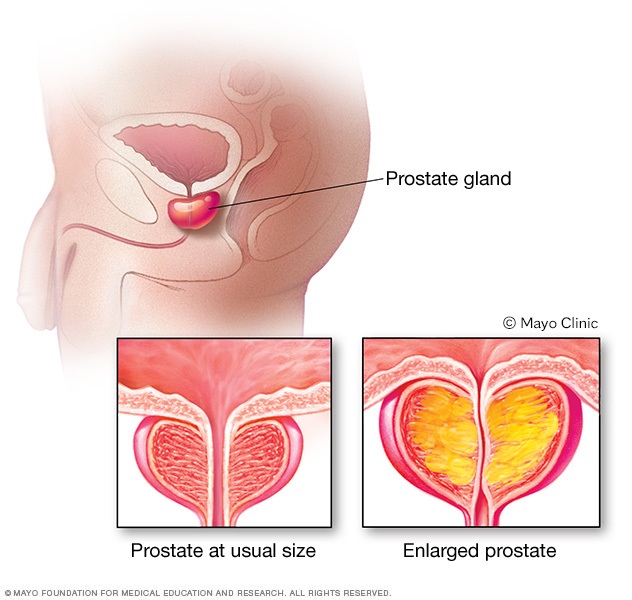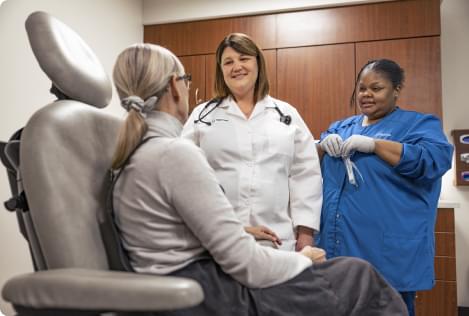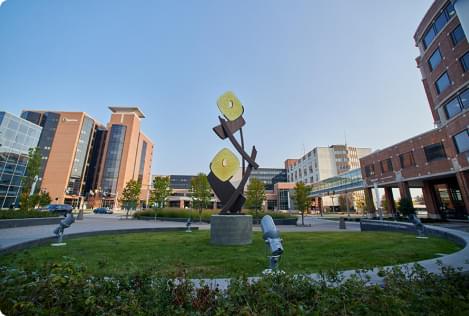Overview
Benign prostatic hyperplasia (BPH) is a health issue that becomes more common with age. It's also called an enlarged prostate. The prostate is a small gland that helps make semen. It's found just below the bladder. And it often gets bigger as you get older.
An enlarged prostate can cause symptoms that may bother you, such as blocking the flow of urine out of the bladder. It also can cause bladder, urinary tract or kidney problems.
Many treatments can help BPH. These include medicines, surgery and other procedures. Your health care provider can help you choose. The right option depends on things such as:
- Your symptoms.
- The size of your prostate.
- Other health problems you might have.
Symptoms
Common symptoms of BPH include:
- Frequent or urgent need to pee, also called urination.
- Peeing more often at night.
- Trouble starting to pee.
- Weak urine stream, or a stream that stops and starts.
- Dribbling at the end of urination.
- Not being able to fully empty the bladder.
Less common symptoms include:
- Urinary tract infection.
- Not being able to pee.
- Blood in the urine.
The symptoms of BPH tend to slowly get worse. But sometimes they stay the same or even improve over time.
The size of the prostate doesn't always determine how serious the symptoms are. Some people with slightly enlarged prostates can have major symptoms. Others who have very enlarged prostates can have minor problems. And some people with enlarged prostates don't have any symptoms at all.
Other possible causes of urinary symptoms
Some other health problems can lead to symptoms that are like those caused by enlarged prostate. These include:
- Urinary tract infection.
- Inflamed prostate.
- Narrowing of the urethra, the tube that carries urine out of the body.
- Scarring in the bladder neck due to past surgery.
- Bladder or kidney stones.
- Problems with nerves that control the bladder.
- Cancer of the prostate or bladder.
Some medicines also may lead to symptoms that seem like those caused by BPH. These include:
- Powerful pain-relieving medicines called opioids.
- Cold and allergy medicines.
- Older medicines for depression called tricyclic antidepressants.
When to see a doctor
Talk to your health care provider about your symptoms, even if they don't bother you. It's important to find out if there are any causes that could be treated. Without treatment, the risk of a dangerous blockage of the urinary tract can rise.
If you can't pass any urine, get medical help right away.
Causes
The prostate gland is located beneath the bladder. The tube that moves urine from the bladder out of the penis is called the urethra. This tube passes through the center of the prostate. When the prostate gets bigger, it starts to block urine flow.
The prostate is a gland that typically keeps growing throughout life. This growth often enlarges the prostate enough to cause symptoms or to block urine flow.
It isn't clear what causes the prostate to get bigger. It might be due to changes in the balance of sex hormones as you grow older.

Risk factors
Risk factors for an enlarged prostate include:
- Aging. An enlarged prostate gland rarely causes symptoms before age 40. After that, the chance of having an enlarged prostate and related symptoms starts to rise.
- Family history. Having a blood relative with prostate problems makes you more likely to have problems with your prostate.
- Diabetes and heart disease. Studies show that diabetes might raise the risk of BPH. So might heart disease.
- Lifestyle. Obesity raises the risk of BPH. Exercise can help lower the risk.
Complications
Complications of an enlarged prostate can include:
- Not being able to pee. This also is called urinary retention. You might need to have a tube called a catheter placed into your bladder to drain the urine. Some people with an enlarged prostate need surgery to get relief.
- Urinary tract infections (UTIs). Not being able to fully empty the bladder can raise the risk of infection in the urinary tract. If you often get UTIs, you might need surgery to remove part of the prostate.
- Bladder stones. These are most often caused by being unable to fully empty the bladder. Bladder stones can cause illness, bladder irritation, blood in the urine and blocked urine flow.
- Bladder damage. A bladder that doesn't empty fully can stretch and weaken over time. As a result, the muscular wall of the bladder no longer squeezes properly to force urine out. And this makes it harder to fully empty the bladder.
- Kidney damage. Pressure in the bladder from not being able to pee can damage the kidneys or let bladder infections reach the kidneys.
Treatment for BPH lowers the risk of these complications. But urinary retention and kidney damage can be serious health threats.
Having an enlarged prostate is not thought to raise the risk of getting prostate cancer.
Diagnosis
Your health care provider likely will start by asking questions about your symptoms. You'll also get a physical exam. This exam is likely to include:
- Digital rectal exam. The provider inserts a finger into your rectum to check if your prostate is enlarged.
- Urine test. A lab checks a sample of your urine to find out if you have an illness or other problems that can cause the same symptoms as those of BPH.
- Blood test. The results can show if you have kidney problems.
After that, you might need other tests that can help confirm an enlarged prostate. These tests include:
- Prostate-specific antigen (PSA) blood test. PSA is a protein made in the prostate. PSA levels go up when the prostate becomes enlarged. But higher PSA levels also can be due to recent procedures, illnesses, surgery or prostate cancer.
- Urinary flow test. You pee into a container attached to a machine. The machine measures how strong your urine flow is and how much urine you pass. Test results can show over time whether your condition is getting better or worse.
- Postvoid residual volume test. This test measures whether you can empty your bladder fully. The test can be done using an imaging exam called ultrasound. Or it can be done with a tube called a catheter placed into your bladder after you pee to measure how much urine is left in the bladder.
- 24-hour voiding diary. This involves noting how often and how much you pee. It might be extra helpful if you make more than a third of your daily urine at night.
If your health problem is more complex, you may need tests including:
- Transrectal ultrasound. A device that uses sound waves to make pictures is inserted into the rectum. It measures the size of the prostate.
- Prostate biopsy. This test uses ultrasound imaging to guide needles that take tissue samples of the prostate. Checking the prostate tissue can help your doctor find out if you have prostate cancer.
- Urodynamic and pressure flow studies. A catheter is threaded through the urethra into the bladder. Water — or, less often, air — is slowly sent into the bladder to measure bladder pressure and check how well the bladder muscles work when you try to pass urine.
- Cystoscopy. A lighted, flexible tool is placed into the urethra. It lets a provider see inside the urethra and bladder. Before this test, you may be given a topical medicine that numbs the urethra.
Treatment
Many treatments are available for enlarged prostate. These include medicines, surgery and procedures that involve smaller, fewer or no cuts. The best treatment choice for you depends on:
- The size of your prostate.
- Your age.
- Your overall health.
- How serious your symptoms are.
If your symptoms don't get in the way of your life, you might decide to put off treatment. Instead, you could wait to see if your symptoms change or get worse. For some people, symptoms of BPH can ease without treatment.
Medicines for an enlarged prostate
Taking medicine is the most common treatment for mild to moderate symptoms of an enlarged prostate. Options include:
- Alpha blockers. Alpha blockers work by relaxing the smooth muscle of the bladder neck and prostate. This makes peeing easier. Alpha blockers include alfuzosin (Uroxatral), doxazosin (Cardura), tamsulosin (Flomax) silodosin (Rapaflo) and terazosin. They often work quickly in people with somewhat smaller prostates. Side effects might include dizziness. They also may include a harmless issue in which semen goes back into the bladder instead of out the tip of the penis. This is called retrograde ejaculation.
- 5-alpha reductase inhibitors. These medicines shrink the prostate. They do this by preventing hormone changes that cause the prostate to grow. Examples include finasteride (Proscar) and dutasteride (Avodart). They might take up to six months to work well and can cause sexual side effects.
- Combination therapy. Your health care provider might suggest that you take an alpha blocker and a 5-alpha reductase inhibitor at the same time if either medicine alone doesn't help enough.
- Tadalafil (Cialis). This medicine is often used to treat erectile dysfunction. Studies suggest it also can treat an enlarged prostate.
Surgery and other treatments for an enlarged prostate
Surgery or other procedures might help with BPH symptoms if you:
- Don't get enough relief from medicines.
- Prefer not to try medicine.
- Aren't able to pee.
- Have kidney problems.
- Keep getting bladder stones, blood in the urine or UTIs.
Surgery or other procedures might not be an option if you have:
- An untreated urinary tract infection.
- Urethral stricture disease.
- A history of prostate radiation therapy or urinary tract surgery.
- A neurological disorder, such as Parkinson's disease or multiple sclerosis.
Any type of prostate procedure can cause side effects. Depending on the procedure you choose, health issues afterward might include:
- Semen flowing backward into the bladder instead of out through the penis during ejaculation.
- Leaking urine by accident.
- Urinary tract infection.
- Bleeding.
- Erectile dysfunction.
There are many types of surgeries and other procedures that can treat an enlarged prostate.
Transurethral resection of the prostate (TURP)
A thin tool with a light, called a scope, is inserted into the urethra. The surgeon removes all but the outer part of the prostate. TURP often relieves symptoms quickly. Some people have a stronger urine flow soon after the procedure too. After TURP, you might need a catheter to drain your bladder for a little while.
Transurethral incision of the prostate (TUIP)
A lighted scope is inserted into the urethra. The surgeon makes one or two small cuts in the prostate gland. This makes it easier for urine to pass through the urethra. TUIP might be an option if you have a small or slightly enlarged prostate gland. It also may be an option if you have health problems that make other surgeries too risky.
Transurethral microwave thermotherapy (TUMT)
A special catheter is placed through the urethra into the prostate area. Microwave energy from the catheter destroys the inner portion of the enlarged prostate gland. This shrinks the prostate and eases urine flow. TUMT might relieve only some of your symptoms. It also might take some time before you notice results. In general, this surgery is used only on small prostates in special situations because the treatment might be needed again.
Laser therapy
A high-energy laser destroys or removes overgrown prostate tissue. Laser therapy has a lower risk of side effects than does nonlaser surgery. It might be used in people who shouldn't have other prostate procedures because they take blood-thinning medicines.
Laser therapy options include:
- Ablative procedures. These destroy prostate tissue that blocks urine flow. Types of these procedures include photoselective vaporization of the prostate (PVP) and holmium laser ablation of the prostate. Ablative procedures can cause irritating symptoms after surgery. In rare cases, another procedure to remove prostate tissue might be needed at some point.
- Enucleative procedures. These treatments include holmium laser enucleation of the prostate (HoLEP). In general, they remove all the prostate tissue blocking urine flow and prevent tissue from growing back. The removed tissue can be checked for prostate cancer and other health problems.
Prostate lift
Special tags are used to compress the sides of the prostate. This can improve the flow of urine. A prostate lift might be an option if the middle section of the prostate gland doesn't get in the way of urine flow. It's less likely to cause sexual side effects than are many other surgical treatments.
Water vapor thermal therapy (WVTT)
A device is placed in the urethra. It turns water into steam. This wears away extra prostate tissue. WVTT can ease symptoms of an enlarged prostate. It is less likely to cause sexual side effects compared with many other surgical treatments.
Robotic waterjet treatment
This procedure uses imaging tests and robotic tools to guide a device into the urethra. The device releases tiny, powerful jets of water to remove extra prostate tissue. This can ease symptoms of an enlarged prostate. Robotic waterjet treatment can cause some of the same side effects that TURP can cause.
Open or robot-assisted prostatectomy
One or more cuts are made in the lower stomach area. This lets the surgeon reach the prostate and remove tissue. In general, this type of surgery is done if you have a large or very large prostate. A short hospital stay is often needed afterward. The surgery is linked with a higher risk of needing donated blood due to bleeding.
Embolization
In this procedure, the blood supply to or from the prostate is blocked in chosen areas. This causes the prostate to get smaller. Some evidence suggests there may be a short-term benefit of prostate artery embolization for certain people with BPH. But there's not yet enough evidence for doctors to routinely recommend this procedure over other, more widely available BPH procedures. More research is needed.
Because of the risk for potential complications, embolization needs to be done by specially trained surgical teams.
Follow-up care
Your follow-up care will depend on the technique used to treat your enlarged prostate. Your health care provider should tell you what activities to stay away from and for how long.
Lifestyle and home remedies
You can do things at home to help control the symptoms of an enlarged prostate.
Try to make healthy diet and exercise changes:
- Drink less at night. Don't drink anything for an hour or two before bedtime. This helps prevent trips to the bathroom overnight.
- Limit caffeine and alcohol. They can cause the body to make more urine, irritate the bladder and make symptoms worse.
- Watch what you eat. Foods with lots of seasoning can irritate the bladder.
- Become more active. Exercise can help reduce urinary problems caused by an enlarged prostate.
- Stay at a healthy weight. Obesity is linked with an enlarged prostate.
Also try these bathroom habits:
- Go when you first feel the urge. Waiting too long might stretch the bladder muscle too much and cause damage.
- Plan bathroom breaks. Try to pee at regular times, such as every couple of hours, during the day. This can be useful if you need to pee often and urgently.
- Pee and then pee again a few moments later. This practice is known as double voiding.
Other things that might help include:
- Limiting decongestants or antihistamines. These medicines tighten the band of muscles around the urethra that control urine flow. This makes it harder to pee.
- Staying warm. Colder temperatures can cause urine retention and increase the urgency to urinate.
Alternative medicine
In the United States, no herbal supplements are approved to treat an enlarged prostate.
Guidelines from the American Urological Association say that many studies on supplements used for BPH have weaknesses, such as not being studied for enough time. Two stronger studies of people with BPH found that saw palmetto had no benefits over a harmless treatment that contained no medicine, called a placebo.
Other herbal supplements include beta-sitosterol extracts, pygeum and rye grass. These have been suggested by some as helpful for easing enlarged prostate symptoms. But the safety and long-term effectiveness of these supplements hasn't been proved.
If you take any herbal remedies, tell your health care provider. Certain herbal products might raise the risk of bleeding or affect other medicines that you take.
Preparing for an appointment
For an enlarged prostate, you might be referred to a doctor who specializes in urinary issues, called a urologist.
What you can do
- Take note of your symptoms, including any that may seem unrelated to the reason for which you made the appointment.
- Keep track of how often and when you pee, whether you feel you're fully emptying your bladder, and how much liquid you drink.
- Make a list of key medical information, including other health problems you might have.
- Make a list of all medicines, vitamins or supplements that you take.
- Write down questions to ask your health care provider.
Questions to ask your doctor
For BPH, some questions to ask your health care provider are:
- Do I have an enlarged prostate, or could something else be causing my symptoms?
- What kinds of tests do I need?
- What are my treatment options?
- How can I manage other health problems along with an enlarged prostate?
- Are there any restrictions on sexual activity?
Feel free to ask other questions during your appointment.
What to expect from your doctor
Your provider is likely to ask you some questions. Be ready to answer them. It might give you more time to talk about your concerns.
You'll probably be asked questions about your symptoms, such as:
- When did your symptoms start? Do you have them often or just once in a while? And have they gotten worse over time?
- How often do you pee during the day? And how often do you need to get up at night to pee?
- Do you ever leak urine?
- Do you have a frequent or urgent need to pee?
- Is it hard for you to start peeing? Do you start and stop when you urinate, or feel like you have to strain to urinate?
- Does it ever feel like you haven't fully emptied your bladder?
- Is there any burning when you pee, pain in your bladder area or blood in your urine? Have you had urinary tract infections?
You might also be asked questions about your health history and diet, such as:
- Have any family members had an enlarged prostate, prostate cancer or kidney stones?
- Have you ever had any trouble getting and keeping an erection? Do you have any other sexual problems?
- Have you ever had surgery or another procedure that involved a medical device being placed through the tip of your penis into your urethra?
- Do you take any blood-thinning medicines such as aspirin, warfarin (Jantoven) or clopidogrel (Plavix)?
- How much caffeine do you have each day? What fluids and how much of them do you drink?
© 1998-2024 Mayo Foundation for Medical Education and Research (MFMER). All rights reserved. Terms of Use


